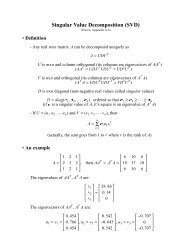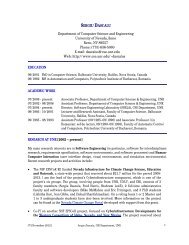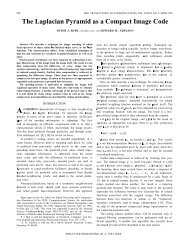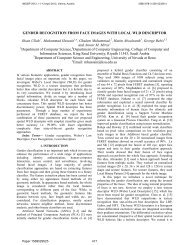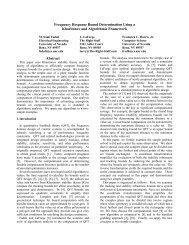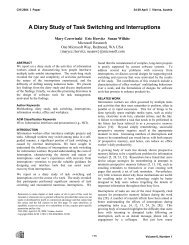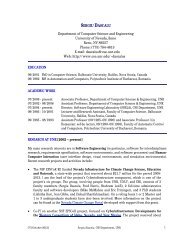Blind Copy Move Image Forgery Detection Using Dyadic
Blind Copy Move Image Forgery Detection Using Dyadic
Blind Copy Move Image Forgery Detection Using Dyadic
You also want an ePaper? Increase the reach of your titles
YUMPU automatically turns print PDFs into web optimized ePapers that Google loves.
BLIND COPY MOVE IMAGE FORGERY DETECTION<br />
USING DYADIC UNDECIMATED WAVELET TRANSFORM<br />
Ghulam Muhammad 1, 3 , Muhammad Hussain 1 , Khalid Khawaji 1 1, 2<br />
, and George Bebis<br />
1 College of Computer and Information Sciences, King Saud University, Riyadh, Saudi Arabia<br />
2 Dept. of Computer Science and Engineering, University of Nevada, Reno, USA<br />
3 Email: ghulam@ksu.edu.sa<br />
ABSTRACT<br />
In this paper, we propose a blind copy move image forgery<br />
detection method using dyadic wavelet transform (DyWT).<br />
DyWT is shift invariant and therefore more suitable than<br />
discrete wavelet transform (DWT) for data analysis. First we<br />
decompose the input image into approximation (LL1) and<br />
detail (HH1) subbands. Then we divide LL1 and HH1<br />
subbands into overlapping blocks and measure the similarity<br />
between blocks. The key idea is that the similarity between<br />
the copied and moved blocks from the LL1 subband should<br />
be high, while the one from the HH1 subband should be low<br />
due to noise inconsistency in the moved block. We sort pairs<br />
of blocks based on high similarity using the LL1 subband<br />
and high dissimilarity using the HH1 subband. <strong>Using</strong><br />
thresholding, we obtain matched pairs from the sorted list as<br />
copied and moved blocks. Experimental results show the<br />
effectiveness of the proposed method over competitive<br />
methods using DWT and the LL1 or HH1 subbands only.<br />
Index Terms— <strong>Dyadic</strong> wavelets transform, copy-move,<br />
image forgery, image forensics<br />
1. INTRODUCTION<br />
Digital imaging has matured to become the dominant<br />
technology for creating, processing, and storing pictorial<br />
memory and evidence. Though this technology brings many<br />
advantages, it can be used as a misleading tool for hiding<br />
facts and evidences. This is because today digital images can<br />
be manipulated in such perfection that forgery cannot be<br />
detected visually. In fact, the security concern of digital<br />
content has arisen a long time ago and different techniques<br />
for validating the integrity of digital images have been<br />
developed. These techniques can be divided into two major<br />
groups: intrusive and non intrusive. In intrusive (active)<br />
techniques, some sort of signature (watermark, extrinsic<br />
fingerprint) is embedded into a digital image, and<br />
authenticity is established by verifying if the true signature<br />
matches the retrieved signature from the test image [1, 2,<br />
and 3]. This approach is limited due to the incapacity of<br />
many digital cameras and video recorders available in the<br />
market to embed extrinsic fingerprints [4].<br />
The limitations of intrusive techniques have motivated<br />
the need for non-intrusive (blind) techniques [5, 6, 7, 8, 9,<br />
and 10] to validate the authenticity of digital images. These<br />
techniques exploit different kinds of intrinsic fingerprints<br />
such as sensor noise of the capturing device or image<br />
specific detectable changes for detecting forgery. There are<br />
many challenges in blind techniques, for instance, reducing<br />
false positive rates (i.e., an authentic image being detected<br />
as a forged image), making the system fully automated,<br />
localizing the forgery, detecting forgery of any type of image<br />
format (compressed or uncompressed), increasing the<br />
robustness and reliability, etc.<br />
Existing blind techniques have their limitations. For<br />
example, (a) need many prior images to estimate the<br />
intrinsic fingerprints, which is a serious bottleneck (i.e., in<br />
potential situations only one image is provided) [5] [9], and<br />
(b) use one image but the method used for noise estimation<br />
is not robust because it is based on the Discrete Wavelet<br />
Transform (DWT) [8]. This is mainly because DWT is<br />
decimated and is not translation invariant, resulting in many<br />
large wavelet coefficients across several scales, creating<br />
problems in noise estimation.<br />
In this paper, we propose a blind method for copy move<br />
image forgery detection using dyadic wavelets. <strong>Copy</strong> move<br />
is one of the most common techniques used for image<br />
forgery. In this type of forgery, one or more objects in an<br />
image are hidden by copying a part and moving it to another<br />
place of the same image. Some sophisticated image editing<br />
tools make this type of forgery undetectable in the naked eye<br />
by applying a „soft‟ touch at the edges of the moved part. As<br />
the color and texture of the moved part is compatible with<br />
those of the copied part, it is very difficult to distinguish<br />
between these two parts. Also, two or more identical objects<br />
in the same original image contribute to the level of<br />
difficulty of forgery detection. Most of the existing copy<br />
move forgery detection methods either rely on similarity<br />
measurements or noise deviation measurements between the<br />
parts (blocks of an image). The proposed forgery detection<br />
method utilizes two types of information for detecting copy<br />
move forgery: (a) similarity between copied and moved
parts in the smoothed version of the image and (b) noise<br />
inconsistency between these parts caused by the forgery.<br />
Here, we use the dyadic wavelet transform, which is<br />
translation invariant. Moreover, we use the scaling<br />
coefficients (LL1) and wavelet coefficients (HH1) at scale<br />
one to obtain a smoothed version and noise estimation,<br />
respectively.<br />
The rest of the paper is organized as follows. Section 2<br />
reviews some of the previous methods in copy move forgery<br />
detection. Section 3 describes the proposed method.<br />
Experimental results and discussions are provided in Section<br />
4, while Section 5 presents our conclusions.<br />
2. PREVIOUS WORKS ON COPY MOVE FORGERY<br />
DETECTION<br />
Quite a few works have been reported on copy move image<br />
forgery detection. A bibliography on blind image forgery<br />
detection methods can be found in [11]. Bayram et al [12]<br />
use a scale and rotation invariant Fourier-Mellin Transform<br />
(FMT) and the notion of bloom filters to detect copy-move<br />
forgery. Their method is computationally efficient and can<br />
detect forgery in highly compressed images. <strong>Copy</strong> move<br />
forgery detection based on blur moment invariants has been<br />
proposed in [13]. This method can detect duplicated regions<br />
degraded by blurring or corrupted with noise. Huang et al<br />
[14] have proposed a copy move forgery detection method<br />
based on Scale Invariant Feature Transform (SIFT)<br />
descriptors. After extracting the descriptors of different<br />
regions, they match them with each other to find possible<br />
forgery in images. A sorted neighborhood approach based<br />
on DWT and Singular Value Decomposition (SVD) has<br />
been proposed in [15]. In this method, first DWT is applied<br />
to the image and then SVD is used on low-frequency<br />
components to reduce their dimension. SV vectors are then<br />
lexicographically sorted, where duplicated blocks will be<br />
close in the sorted list. Solario and Nandi [16] use log-polar<br />
coordinates to obtain a one dimensional descriptor invariant<br />
to reflection, rotation, and scaling for detecting duplicated<br />
regions. The Discrete Cosine Transform (DCT) was used in<br />
[17]. They use lexicographic sorting after extracting DCT<br />
coefficients of each block in an image. A computationally<br />
efficient method based on Principal Component Analysis<br />
(PCA) was presented in [18]. The DWT and phase<br />
correlation based method was proposed in [19]. Their<br />
algorithm is based on pixel matching to locate copy move<br />
regions. Sutcu et al [20] proposed tamper detection based on<br />
the regularity of wavelet coefficients. In their method, they<br />
used undecimated DWT. Regularity in sharpness or<br />
blurriness is measured in the decay of wavelet coefficients<br />
across scales.<br />
Most of the above methods suffer from false positives.<br />
Therefore, human interpretation is necessary to obtain the<br />
correct result [11].<br />
3. PROPOSED METHOD<br />
We propose a robust blind copy move image forgery<br />
detection method using the dyadic (undecimated) wavelet<br />
transform (DyWT). After extracting low frequency<br />
component (approximate) LL1 and high frequency<br />
component (detail) HH1 at scale one, a similarity measure is<br />
applied between the blocks in LL1 and HH1 separately. A<br />
decision is made based on the similarity between blocks in<br />
LL1 and dissimilarity between the blocks in HH1.<br />
3.1. <strong>Dyadic</strong> wavelet transform<br />
Many previous methods on copy move forgery detection use<br />
DWT. However due to its lack of shift invariance, the<br />
analysis of data is far from optimal. To overcome this<br />
drawback of DWT, Mallat and Zhong [21] introduced the<br />
DyWT, which is shift invariant. In this case, the wavelet<br />
transform does not involve downsampling and the number of<br />
wavelet coefficients does not shrink between the scales like<br />
in DWT.<br />
Let I be the image to be decomposed, and h[k] and g[k]<br />
be the scaling (low pass) and wavelet (high pass) filters. The<br />
DyWT of an image can be computed using the following<br />
atrous algorithm.<br />
0<br />
Start at scale j = 0, and take I I , and compute the<br />
scaling and wavelet coefficients at scales j = 1, 2, …, J using<br />
Eqs. (1) and (2):<br />
<br />
j<br />
j j<br />
c [ n]<br />
h[<br />
k]<br />
c [ n 2 k]<br />
1 (1)<br />
k<br />
<br />
j1<br />
j j<br />
d [ n]<br />
g[<br />
k]<br />
c [ n 2 k]<br />
. (2)<br />
Let h [k]<br />
j<br />
2 <br />
j<br />
1<br />
k<br />
and g [k]<br />
j<br />
be the filters obtained by inserting<br />
zeros between the terms of h[k] and g[k]. Then we<br />
can perform DyWT using filtering as follows:<br />
Start with I, which is assumed to be at scale zero,<br />
0<br />
i.e., I I .<br />
To obtain the scaling and wavelet coefficients I j<br />
and D j at scales j = 1, 2, …, J<br />
o filter<br />
o filter<br />
j1<br />
j1<br />
I with h [ k]<br />
j1<br />
j1<br />
I with g [ k]<br />
The following diagram (Figure 1) illustrates this<br />
algorithm one level decomposition.<br />
,<br />
.
j1<br />
c<br />
Row<br />
j1<br />
c<br />
j1<br />
h k<br />
g j<br />
[ ]<br />
1<br />
[ k]<br />
j<br />
c<br />
Figure 1. One level decomposition of DyWT.<br />
Column<br />
[ ]<br />
j1<br />
h k<br />
Column<br />
[ ]<br />
j1<br />
g k<br />
j1<br />
h k<br />
[ ]<br />
j1<br />
g k<br />
[ ]<br />
j1<br />
g k<br />
[ ]<br />
d<br />
j<br />
j<br />
c ( LL)<br />
j<br />
d H ( LH)<br />
j<br />
j 1<br />
h [ k]<br />
d V ( HL)<br />
j<br />
d D(<br />
HH)<br />
Figure 2. One level decomposition of DyWT of a 2D image.<br />
As mentioned, there is no downsampling involved in<br />
DyWT. In the wavelet transform, I J is called the low pass<br />
subband (L) and Dj are called the high pass subbands (H). In<br />
the case of two dimensional signals like images, we find four<br />
subbands LL, LH, HL, and HH at each scale of the<br />
decomposition. The size of each of these subbands is the<br />
same as the original image. We can decompose a 2D image<br />
using DyWT along rows and columns as illustrated in Figure<br />
2.<br />
3.2. Steps of the proposed method<br />
Figure 3 shows the steps involved in the proposed copy<br />
move image forgery detection method.<br />
In the proposed method, first, the image in question is<br />
decomposed using DyWT up to scale one. We use only LL1<br />
and HH1 for further processing. The LL1 subband is an<br />
approximation of the image which is better for duplicate<br />
identification. The HH1 subband encodes noise present in<br />
the image, which is distorted while performing the forgery.<br />
HH1 actually contains high frequency information, which<br />
consists of mostly due to noise and sharp edges. In the case<br />
of color images, first we convert them to gray-scale before<br />
applying DyWT.<br />
The LL1 and HH1 subbands are then divided into<br />
16×16 pixel blocks with 8 pixel overlapping in both row and<br />
column. We assume that copy move forgery is performed in<br />
at least 16×16 pixel. Copied and moved blocks in LL1<br />
should exhibit similarity between them. However, while<br />
performing the image forgery, the noise pattern, which is an<br />
intrinsic fingerprint of an image, is distorted. Therefore,<br />
copied and moved blocks should exhibit high dissimilarity<br />
between them in the HH1 subband. We calculate the<br />
similarity using the Euclidean distance:<br />
Calculate Euclidean<br />
distance between<br />
every pair of blocks<br />
DyWT<br />
LL HH<br />
Divide into<br />
overlapping<br />
blocks<br />
Sort in<br />
ascending<br />
order<br />
Input <strong>Image</strong><br />
Divide into<br />
overlapping<br />
blocks<br />
Calculate Euclidean<br />
distance between<br />
every pair of blocks<br />
Sort in<br />
descending<br />
order<br />
Find match using threshold<br />
between the sorted list<br />
Decision<br />
Figure 3. Flowchart of the proposed copy move image<br />
forgery detection.<br />
n 1<br />
2<br />
d(<br />
p,<br />
q)<br />
pi<br />
qi<br />
<br />
(3)<br />
N i1<br />
where d(p,q) gives the distance between blocks p and q, pi<br />
and qi are corresponding LL1 or HH1 transform coefficient<br />
values and N is the total number of pixels in a block. In our<br />
case, N = 256. The distances are normalized by the<br />
maximum distance to scale the values between 0 and 1.<br />
Before calculating the distance, we arrange the pixels of a<br />
block in one dimensional vector.<br />
The distances found using LL1 are then sorted in<br />
ascending order (List 1), putting highly similar pairs of<br />
blocks at the top of the list. We discard all the pairs of<br />
blocks that have distances > 0.7. We refer to this value as<br />
threshold 1 (Th1). On the contrary, the distances calculated<br />
using HH1 are sorted in descending order (List 2); this<br />
places pairs of blocks with highly inconsistent noise at the<br />
top. Again we discard all the pairs of blocks that have<br />
distances lower than 0.3. We refer to this value as threshold<br />
2 (Th2). Now, if a pair of blocks according to its distance<br />
appears at the similar location in both of the lists (List 1 and<br />
List 2), then the pair is detected as copied and moved block.<br />
For example, if block pair (p, q) is located at nth location in<br />
List 1, and nth or (n+1)th or (n-1)th location in List 2, then<br />
the pair is detected as copy-move blocks. The values of Th1<br />
and Th2 were chosen as optimal after several trials.<br />
It should be mentioned that there may be similar objects<br />
in an original (not forged) image. In the case of LL1<br />
subband only, similar objects will be identified as copymoved<br />
objects resulting in false positives. On the other<br />
hand, in the HH1 subband, these objects will not be
(a)<br />
(d)<br />
(b)<br />
Figure 4. (a) The original image. (b) The forged image where the middle red flower is a copy of the right red flower. (c)<br />
The result of the proposed method. (d) The result of the method in [15]; it shows false positives. (e) The result using modified<br />
[8]; it shows truncated area of forgery.<br />
identified as copy-moved because of low dissimilarity in<br />
noise level. Therefore, we capitalize both on LL1 and HH1<br />
to avoid false positives.<br />
4. EXPERIMENTAL RESULTS<br />
The proposed method was evaluated on several test images<br />
that were forged using copy-move operation. There were 10<br />
different image sources and the forgeries on these sources<br />
were done using Adobe Photoshop tool. The test images,<br />
both original and forged, can be found at<br />
http://faculty.ksu.edu.sa/ghulam/Pages/<strong>Image</strong>Forensics.aspx.<br />
Figure 4 shows an example using the proposed method<br />
assuming a color copy-move forged image. The image was<br />
forged by copying the right red flower and moving it to the<br />
middle position (i.e., middle red flower is a copy of right red<br />
flower). Figure 4 (c) shows the output of the proposed<br />
method. The black area is identified as copy and move area.<br />
We compared our method with that in [15] that uses DWT<br />
and LL, and the one in [8] that uses DWT and HH1. We<br />
modified the method in [8] in the sense that instead of<br />
comparing the median of each block, we used Euclidean<br />
distances as described in Eq. (3). Figure 4 (d, e) shows the<br />
results produced by the methods in [15] and modified [8],<br />
respectively. Figure 4 (d) shows some false positives and<br />
Fig. 4 (e) shows some missing area of copy and move<br />
blocks.<br />
We tested the proposed method on several test images<br />
with different copy-move forgery. There were a total of 574<br />
(e)<br />
copied 16×16 blocks (i.e., a total of 574 + 574 = 1148<br />
blocks of copy-move). We considered a block as forged if<br />
more than 50% of that block area was copied / moved. The<br />
effect<br />
Figure 5. False positive rates (%) for different threshold<br />
values of Th1 and Th2 with the proposed method.<br />
of thresholds Th1 and Th2 on false positive rate is shown in<br />
Fig. 5. From the figure, we can see that when the values of<br />
Th1 and Th2 are increased, false positive rate is also<br />
increased. The false positive rate is greater than 10% when<br />
the value of the pair is higher than <br />
and .<br />
(c)
Table 1 gives a comparison between the proposed<br />
method and the methods of [15] and modified [8] in terms of<br />
detected forged blocks out of 1148. It should be mentioned<br />
that although [15] shows comparable performance to the<br />
proposed method, it suffers from many false positives. The<br />
results shown with the proposed method use Th1 = 0.7 and<br />
Th2 = 0.3 that give the best accuracy.<br />
Example results of two other test images are shown in<br />
Fig. 6 and Fig. 7.<br />
Table 1. Number of blocks identified as copy move out of<br />
1148 copy move blocks using different methods.<br />
Proposed<br />
method<br />
Accuracy 1101<br />
(95.90%)<br />
False<br />
Positive (%)<br />
Method of<br />
[15]<br />
1045<br />
(91.03%)<br />
Modified<br />
method of [8]<br />
932 (81.18%)<br />
4.54% 9.65% 10.03%<br />
5. CONCLUSION<br />
We proposed a blind copy move image forgery detection<br />
method based on DyWT. We utilized both the LL1 and HH1<br />
subbands to find similarities and dissimilarities between the<br />
blocks of an image for robust detection of copy move. The<br />
proposed method performed better than some of the<br />
previous methods. We are currently extending the proposed<br />
method to using color information instead of converting the<br />
color images to gray images.<br />
Acknowledgement: This work is supported by the grant 10-<br />
INF1140-02 under the National Plan for Science and<br />
Technology (NPST), Saudi Arabia.<br />
6. REFERENCES<br />
[1] M. M. Yeung, “Digital watermarking,” ACM Commun, vol.<br />
41, no. 7, pp. 30–33, 1998.<br />
[2] C. Rey and J. L. Dugelay, “A survey of watermarking<br />
algorithms for image authentication,” EURASIP Journal on<br />
applied Signal Processing Vol. 2002 N6, pp. 613–621, 2002.<br />
[3] C. Zhang, et al., “Multipurpose Watermarking Based on<br />
Multiscale Curvelet Transform,” IEEE Trans. Inf. Forensics<br />
Security, vol. 3, no. 4, pp. 611–619, December 2008.<br />
[4] H. Farid, “<strong>Image</strong> forgery detection - a survey,” IEEE Signal<br />
Processing Magazine, vol. 5, pp. 16–25, March 2009.<br />
[5] M. Chen, et al., “Determining <strong>Image</strong> Origin and Integrity <strong>Using</strong><br />
Sensor Noise,” IEEE Trans. Inf. Forensics Security, vol. 3, no.<br />
1, pp. 74–90, 2008.<br />
[6] B. Mahdian and S. Saic, “<strong>Blind</strong> Authentication <strong>Using</strong> Periodic<br />
Properties of Interpolation,” IEEE Trans. on Inf. Forensics<br />
Security, vol. 3, no. 3, pp. 529–538, September 2008.<br />
[7] H. Farid, “Exposing Digital Forgeries From JPEG Ghosts,”<br />
IEEE Trans. Inf. Foren. Secu., vol. 4 (1), pp. 154–160, 2009.<br />
[8] B. Mahdian and S. Saic, <strong>Using</strong> Noise Inconsistencies for <strong>Blind</strong><br />
<strong>Image</strong> Forensics, <strong>Image</strong> and Vision Computing, vol. 27, no.<br />
10, pp. 1497-1503, September 2009.<br />
[9] A. Swaminathan, M. Wu, K. J. R. Liu, “Digital <strong>Image</strong><br />
Forensics via Intrinsic Fingerprints,” IEEE Trans. Inf.<br />
Forensics Security, vol. 3, no. 1, 101-117, March 2008.<br />
[10] W.S. Lin, et al., “Digital <strong>Image</strong> Source Coder Forensics via<br />
Intrinsic Fingerprints,” IEEE Transactions on Inf. Forensics<br />
Security, vol. 4(3), pp. 460–475, Sept. 2009.<br />
[11] B. Mahdian and S. Saic, “A bibliography on blind methods<br />
for identifying image forgery,” Signal Processing: <strong>Image</strong><br />
Communication, vol. 25, pp. 389-399, 2010.<br />
[12] S. Bayram, et al., “An efficient and robust method for<br />
detecting copy-move forgery,” Proc. ICASSP09, pp. 1053-<br />
1056, 2009.<br />
[13] B. Mahdian and S. Saic, “<strong>Detection</strong> of copy-move forgery<br />
using a method based on blur moment invariants,” Forens. Sci.<br />
Int., vol. 171, no. 2–3, pp. 180–189, 2007.<br />
[14] H. Huang, et al., “<strong>Detection</strong> of copy-move forgery in digital<br />
images using SIFT algorithm,” Proc. Pacific-Asia Workshop<br />
on Computational Intell. Industrial App., pp. 272- 276, 2008.<br />
[15] G. Li, Q. Wu, D. Tu, and S. Sun, “A sorted neighborhood<br />
approach detecting duplicated forgeries based on DWT and<br />
SVD,” Proc. ICME2007, pp. 1750-1753, 2007.<br />
[16] S. B. Solario and A. K. Nandi, “Passive forensic method for<br />
detecting duplicated regions affected by reflection, rotation,<br />
and scaling,” Proc. EUSIPCO09, pp. 824-828, 2009.<br />
[17] J. Fridrich, et al., “<strong>Detection</strong> of copy-move forgery in digital<br />
images,” Digital Forensic Research Works., pp. 55–61, 2003.<br />
[18] A. C. Popescu and H. Farid, “Exposing digital forgeries by<br />
detecting duplicated image regions,” Technical report, Dept. of<br />
Computer Science, Dartmouth College, 2004.<br />
[19] J. Zhang, H. Wang, and Y. Su, “A new approach of detecting<br />
copy-move forgery in digital images,” Proc. IEEE Int. Conf.<br />
on Communication Systems 2008, pp. 362-366, 2008.<br />
[20] Y. Sutcu, et al., "Tamper <strong>Detection</strong> Based on Regularity of<br />
Wavelet Transform Coefficients," Proc. IEEE ICIP 2007.<br />
[21] S. G. Mallat and S. Zhong, “Characterization of signals from<br />
multiscale edges,” IEEE Trans. Pattern Anal. Machine Intell.,<br />
vol. 14, pp. 710–732, July 1992.
(a)<br />
(d)<br />
(b)<br />
Figure 6. (a) The original image. (b) The upper leaf on right side has been hidden by copying and pasting a portion of the<br />
image from lower corner of the image. (c) The result of the proposed method. (d) The result of the method in [15]. (e) The<br />
result using modified [8].<br />
(a)<br />
(d)<br />
(b)<br />
Figure 7. (a) The original image. (b) The picture in the lower part has been copied and pasted in the upper part and the smaller<br />
picture has been hidden by copying a portion of the image from the upper part of the image. (c) The result of the proposed<br />
method. (d) The result of the method in [15]. (e) The result using modified [8].<br />
(e)<br />
(e)<br />
(c)<br />
(c)



